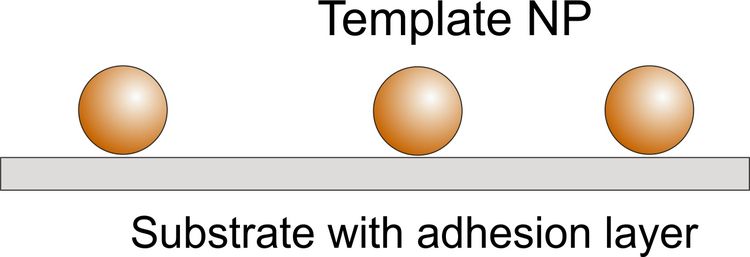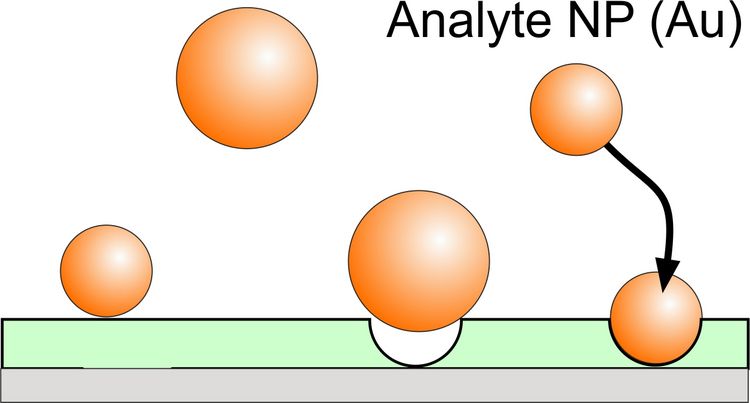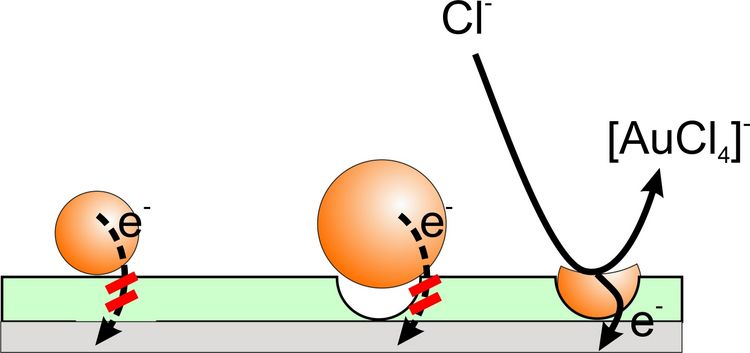Contact
Mailing Address
Visitors
Selective Recognition of Nanoobjects
Concept of Nanoparticle-Imprinted Matrices
by Julia Witt
Nanotoxicity is a new scientific discipline [1, 2] which requires the development of appropriate tools for the determination of nano-objects such as metallic nanoparticles. These tools should provide information about the possible interaction between nano-objects and biological systems. The main aspect of this project concerns the development of so-called nanoparticle imprinted matrices (NAIM) for the selective recognition of nanoparticles by a polymeric matrix. Nanoparticles will be used as templates to imprint organic matrices on solid supports (Figure 1a,b). After releasing the nanoparticles by oxidative dissolution (Figure 1c), the material shall be selective for a reuptake of nanoparticles with the same size and surface functionality (Figure 1d). The imprinted matrices can be used as sensor materials for the speciation of nanoparticles conceptionally similar to the already existing molecular-imprinted polymers [3, 4] (Figure 1e). Such measurement tools have a growing importance as toxicity of nanoparticles depends on size, surface functionality and elements/compounds forming the core [5, 6].





Our Contribution to the Field
In cooperation with the group of Daniel Mandler (Hebrew University Jerusalem), we published for the first time the concept based on nanoparticle-imprinted matrices combined with electrochemical detection of nanoparticles [7]. The new sensor principle was illustrated by a polyaniline film transferred simultaneously with template gold nanoparticles by the Langmuir-Blodgett technique. After electro-oxidation of the gold-nanoparticles, open cavities were detected in the film (Figure 2b) that were able to re-capture analyte nanoparticles with size-exclusion behavior [7]. Currently, we extend our approach for nanoparticle-imprinted matrices to other matrix-nanoparticle combinations and follow new routes for the formation of nanoparticle-imprinted matrices.


Used Techniques
Langmuir-Blodget transfer, X-ray photoelectronspectroscopy, voltammetry, scanning electron microscopy, scanning force microscopy
Own publications
S. A. Samuel, G. Wittstock
Covalent Modification of Nanoparticle-Imprinted Matrices for Selective Nanoparticle Recognition ChemElectroChem 2023, 19, e202300173/1-9. Abstract & Link (open access)
J. Witt, D. Mandler, G. Wittstock
Nanoparticle-Imprinted Matrices as Sensing Layers for Size-Selective Recognition of Silver Nanoparticles
ChemElectroChem. 2016, 3, 2116-2124, Abstract & Link
M. Hitrik, Y. Pisman, G. Wittstock, D. Mandler
Speciation of Nanoscale Objects by Nanoparticle Imprinted Matrices
RSC Nanoscale 2016, 8, 13934-13943, Abstract & Link
M. Bosserdt, J. Erdőssy, G. Lautner, J. Witt, K.Köhler, N. Gajovic-Eichelmann, A. Yarman, G. Wittstock, F.W. Scheller, R.E. Gyurcsányi
Microelectrospotting as a new method for electrosynthesis of surface-imprinted polymer microarrays for protein recognition
Biosens. Bioelectron., 2015, 73, 123-129, Abstract & Link
J. Witt, D. Mandler, G. Wittstock
Magnetically Controlled Release of Dispersed Iron Oxide Nanoparticles from Imprinted Organic Thin Films
ECS Trans. 2015, 66, 1-7, Abstract & Link
S. Kraus-Ophir, J. Witt, G. Wittstock and D. Mandler
Nanoparticle-Imprinted Polymers for Size-Selective Recognition of Nanoparticles
Angew. Chem. Int. Ed. 2014, 53, 294-298, Abstract & Link
S. Kraus-Ophir, J. Witt, G. Wittstock and D. Mandler,
Nanopartikulär geprägte Polymere für die größenenselektive Erkennung von Nanopartikeln,
Angew. Chem., 2014, 126, 300-304, Abstract & Link
Cited Literature
[1] Colvin, V. L. Nat. Biotechnol. 2003, 21, 1166-1170.
[2] Nel, A.; Xia, T.; Mädler, L.; Li, N. Science 2006, 311, 622-627.
[3] Haupt, K. Analyst 2001, 126, 747-756.
[4] Piletsky, S. A.; Turner, A. P. F. Electroanalysis 2002, 14, 317-323.
[5] Leroueil, P. R.; Hong, S.; Mecke, A.; Baker, J. R.; Orr, B. G.; Banaszak Holl, M. M. Acc. Chem. Res. 2007, 40, 335-342.
[6] Bantz, C.; Koshkina, O.; Lang, T.; Galla, H.-J.; Kirkpatrick, C. J.; Stauber, R. H.; Maskos, M. Beilstein J. Nanotechnol. 2014, 5, 1774-1788.
[7] Kraus-Ophir, S.; Witt, J.; Wittstock, G.; Mandler, D. Angew. Chem. Int. Ed. 2014, 53, 294-298.



